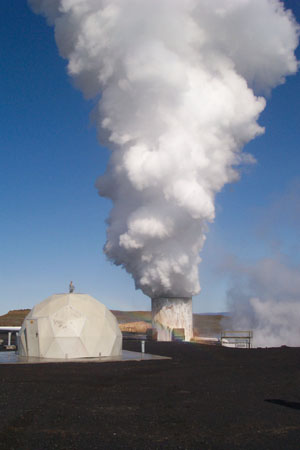 Image via WikipediaBy William Nottoli
Image via WikipediaBy William NottoliGeothermal energy has vast resources that are estimated to be larger than coal, oil, natural gas and uranium combined. There has been numerous survey done to determine how much usable energy is available, and the consensus seems to indicate there is enough resources to last somewhere between 500,000 and 1,000,000 years, which is why it has been classified as a limitless and renewable form of energy.
The most common usage found for geothermal energy is to power the generators for electricity in power plants. The deciding factor for most companies when building any new power plant is the cost of running the plant. When a cost comparison has been done between a new facility that is designed to use geothermal energy, and a new facility that is designed to use fossil fuels.
The cost of operating the geothermal plant is very competitive (4.5 to 7.3 cents per kilowatt hour) to that of the plant that uses fossil fuel to power the turbines. The major difference between the two is that the flame that fossil fuel gives off is full of pollutants, which is one of our major health concerns, while geothermal energy has no flame so the health and safety issues are not there.
The only country that has really benefited so far from geothermal energy is Iceland. No surprise here, it just seems natural with so many geothermal springs on the island and all the volcanic activity they have one might say that Iceland is one big geothermal spring. Currently about 75% of Iceland's power is from geothermal energy and they are striving to be the first county to be 100% free of any dependency on fossil fuels for electricity.
To be able to practically use geothermal, you must first find a hydrothermal site commonly called a geothermal spring. Once you have found a promising site, then you start to drill down to determine if there is sufficient hydrothermal activity. How deep you have to drill is uncertain, normally for every 100 meters (328 feet) you go into the earths crust, the temperature of the rocks will increase by 3 degrees Celsius (5.4 degrees Fahrenheit). Once a geothermal spring has been found, the most common application is to use the power to drive turbines for electricity.
The majority of the geothermal springs are found along the major plate boundaries, which is also where the majority of volcanic activities and earthquakes are concentrated. The most active areas have been located along the "Ring of Fire" which rims the Pacific ocean. A few of the western states that are close to the pacific rim have been using some geothermal energy to supplement their energy needs, California gets about 6% of their electricity from geothermal energy, while Nevada is around 4% and Utah is at about 2%.
There are a couple of limiting factors that will keep geothermal energy from being widely used. One factor is that geothermal springs are found only in limited areas and the other is being able to keep the power plant connected to the hot spots. The Yellowstone area in Idaho, Wyoming and Montana, has many geothermal springs sites, however these springs are always moving along with the tectonic plate, which eliminates the feasibility of building power plants there, since the power source will be moving.
It seems with todays current technology, with Iceland being the exception, geothermal energy, even with its vast resource, will always be a limited form of clean energy when compared to solar and wind power.
William Nottoli
Affiliate Marketing specializing in specific markets and products.
http://www.wrnottoli.com
Previous Careers: retired Air Force, served 20 years, Licensed Realtor for State of Utah, Bonded Loan Officer for State of Utah, Retail and Restaurant Manager
Article Source: http://EzineArticles.com/?expert=William_Nottoli
http://EzineArticles.com/?Geothermal-Energy-It-Is-Abundant,-But-Is-It-Practical?&id=6318460

nice article
ReplyDelete